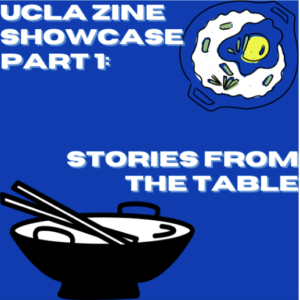This past year, Managing Editor Neelanjana Banerjee worked with amazing students at UCLA in Asian American Studies at 104B: Asian American Publishing with Kaya Press class. In addition to learning about the Asian American publishing industry and the challenges that can occur, these students were also tasked to create and publish a zine all on their own. Students thought of their own concepts, asked for submissions, and designed and published a final project. This is the first in a series of posts sharing these publications.
Part 1: Stories From The Table
In the first installment of this series, we focus on cuisine and food. How does food represent us? How do certain dishes make us feel? What food reminds us of home? What stories do we have related to food? What foods did we grow up with? These zines take a deep dive into food and the relationships individuals have with food and their culture.
Ngon Lắm: Flavors of Home by Eric Au takes a close look into the lives of four Vietnamese college students as they navigate reconnecting with and reclaiming their culture through the lens of traditional foods and memories associated with them.
Oishi by Kristi Uyema centers the delicious foods within the AAPI community. Oishi details different peoples’ experiences with their cultural food and unpacks the impact that certain dishes have had on them.
Stinky Kimchi by Janice Yun spotlights and celebrates different dishes from various AAPI cultures free of shame. The recipes invite readers to take a bite into foods that represent community and home.
Asian American Comfort Food For Hateful Times by Chazz Hannah is a compilation of recipes for comfort foods and stories that describe the power of food during difficult times
Part 2: Stories From Asian America
In the second installment of this series, we focus on the Asian American experience. From poetry unpacking the idea of ‘home’ to discussions of generations of C-pop, “Stories from Asian America” gives the reader an honest look into what it means to be a child caught between two cultures and what that means to them.
Syupeo by Ashley Kim draws parallels between the mundane and the extraordinary by showcasing Asian supermarkets. Syupeo invites readers to look back on their memories and reminisce about the dull mundanity and adored familiarity of their local Asian supermarkets.
Ley Lines by Helen Dang-Vu draws connections between Ley Lines–lines that connect historical structures around the world–and ethnic communities. “Ley Lines” is an ode to ethnic communities and cultural heritage and explores the power of community.
Chrysanthemum by Bella Zhu explores Asian American Identity in the wake of the Covid-19 pandemic and displays the strength and resilience of the community. Chrysanthemum opens up tough conversations about the pandemic and leads readers on the path toward healing.
Calling Home by Vanessa Ta and Christina Ta sheds light on the convoluted way Asian Americans view the idea of home. Calling Home showcases the many ways Asian Americans define family and home.
Homecoming by ____ shares stories and poems of the Asian American experience and finding comfort in your own body. Homecoming discusses topics from fetishization to family and includes an array of alluring photography and artwork.
Gē Mǐ by Annie Jiaying Wu is a love letter to Chinese music and the impact of particular songs on the Chinese American community. Gē Mǐ is a melodious trip through music history and an ode to the Chinese diaspora and their experiences.
Part 3: Stories From The Heart
In the third and final installment, we dive deep into matters of the heart. “Stories from the Heart” aims to display the varied and complex spectrum of human emotion. From discussions of loss to poetry about the feeling of happiness, “Stories from the Heart” invites readers to experience loss and love through the pages of these zines.
Healing at Last by Samreen Siddiqui deep dives into the process of healing and learning through grief. Healing at Last emphasizes the real and shows the beauty and devastation of the process of putting yourself back together through hardship.
Felicity by Jade Lacy tears down the ‘dark and heavy’ stereotype associated with poetry and highlights the often overlooked delicate and jovial “happy” poetry. Felicity invites readers to sift through a world of pure bliss and joy.
Specters & Sensibility by Emily Suh centers on hauntings and the process of healing. Specters & Sensibility is an ode to memory and those who have moved on from our lives, showing what it means to grow through loss.





Leave a Comment
We'd love to know what you think.